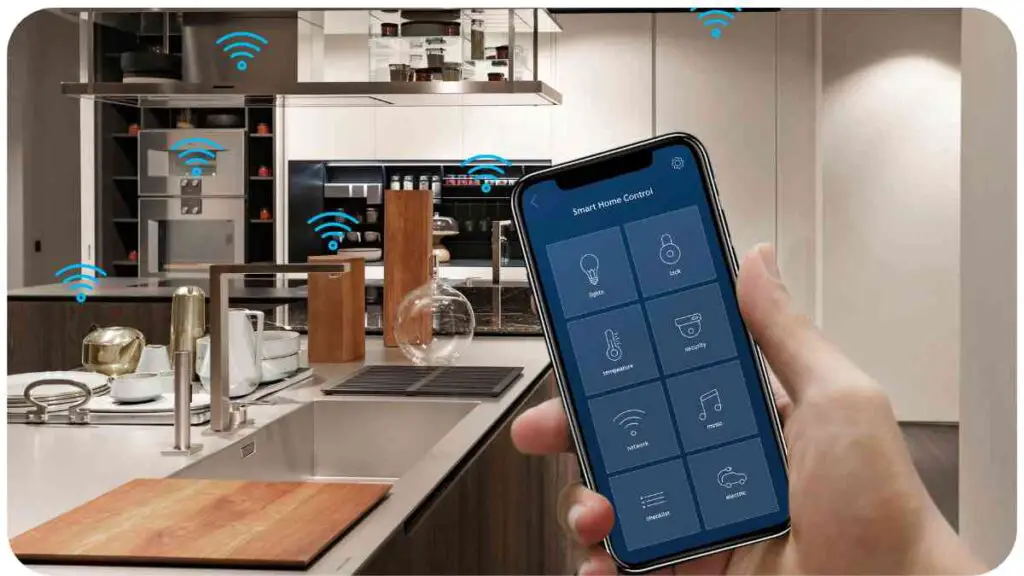1. Introduction
The kitchen has always been the heart of the home, where families gather to prepare meals, share stories, and create memories. With advancements in technology, the concept of the smart kitchen is becoming more prominent bringing together the power of the Internet of Things (IoT) and cooking. This article will delve into the world of IoT in kitchens, exploring how it is revolutionizing the way we cook and experience food.
| Key Takeaways |
|---|
| The future of cooking involves high-tech kitchen appliances that bring convenience and efficiency to the culinary experience. |
| IoT plays a crucial role in creating smart kitchens, offering benefits such as remote monitoring, personalized recommendations, and energy management. |
| Research papers provide insights into IoT in kitchen environments, including its role, design considerations, and user experiences. |
| Privacy and security are important considerations when implementing IoT in kitchens, and measures like encryption and firmware updates can address concerns. |
| Integration with other smart home devices and the use of AI will further enhance personalized and predictive cooking experiences in the future. |
2. Understanding IoT in Kitchens
What is IoT?
The Internet of Things (IoT) refers to the interconnected network of physical devices, vehicles, appliances, and other objects that are embedded with sensors, software, and connectivity, allowing them to collect and exchange data. In the context of kitchens, this means integrating appliances and devices with IoT capabilities to improve functionality, automation, and efficiency.
Thinking of upgrading your kitchen? Learn about the “dos and don’ts” when it comes to installing a smart kitchen backsplash, and discover how this innovative addition can transform your cooking space.
How does IoT apply to kitchens?
IoT in kitchens involves connecting various kitchen appliances and tools to a smart network, enabling users to control and monitor them remotely. This connectivity allows for data exchange, automation, and enhanced culinary experiences, making cooking more convenient, efficient, and enjoyable.
Benefits of IoT in the kitchen
- Convenience: IoT-enabled kitchens streamline processes and make everyday tasks simpler. From preheating the oven remotely to receiving notifications on your smartphone when your meal is ready, IoT brings convenience to cooking.
- Efficiency: With IoT devices, you can automate routine tasks, such as tracking food inventory, managing recipes, and adjusting cooking settings. This automation saves time and energy, allowing you to focus on the creative aspects of cooking.
- Personalization: IoT in kitchens allows for personalized experiences by adapting to your preferences and dietary restrictions. Smart devices can offer recipe recommendations, adjust cooking parameters based on your desired doneness, and even suggest substitutes for missing ingredients.
3. IoT Devices for Smart Kitchens

Smart refrigerators
Table – Brands of Smart Refrigerators
| Brand | Features |
| Samsung | Built-in cameras, inventory tracking |
| LG | Recipe recommendations, freshness tracking |
| Whirlpool | Voice control, temperature adjustment |
Smart refrigerators are equipped with advanced features like built-in cameras, touchscreens, and wireless connectivity. These devices offer benefits such as automatic inventory tracking, recipe recommendations based on available ingredients, and the ability to control and adjust settings remotely.
Looking for convenience in the kitchen? Explore the detailed features of smart home devices like Alexa and how they can seamlessly control your kitchen appliances. Discover the exciting possibilities of voice-activated technology and its impact on your cooking experience.
Connected ovens and stoves
Table – Brands of Connected Ovens and Stoves
| Brand | Features |
| GE | Remote temperature adjustment, preheating |
| Bosch | Recipe synchronization, guided cooking |
| KitchenAid | Smart timer, self-cleaning capabilities |
Connected ovens and stoves allow users to control and monitor their cooking appliances remotely through smartphone apps. These devices offer features like preheating, guided cooking with step-by-step instructions, and even synchronized recipe management.
Intelligent cooking assistants

Table – Brands of Intelligent Cooking Assistants
| Brand | Features |
| Amazon | Voice control, recipe suggestions |
| Integration with smart home devices | |
| Apple | Compatibility with HomeKit ecosystem |
Intelligent cooking assistants, such as Amazon’s Alexa, Google Assistant, and Apple’s Siri, can act as digital sous chefs in your kitchen. With voice commands, these assistants can search for recipes, set timers, provide cooking instructions, and even integrate with other smart home devices for seamless control.
Ensure the longevity and efficiency of your smart fridge with these essential maintenance tips. Discover how proper care and regular upkeep can extend the lifespan of your appliance and optimize its performance. Check out our guide on how to maintain your smart fridge to keep your kitchen running smoothly.
4. Enhancing Culinary Experience with IoT
Recipe recommendations and meal planning
Table – Meal Planning Apps
| App | Features |
| Yummly | Personalized recipe recommendations, smart grocery list creation, recipe saving and organizing |
| Paprika | Recipe management, meal planning, automatic ingredient scaling, grocery list generation |
| Tasty | Step-by-step video recipes, personalized recommendations, meal planning functionality |
IoT in kitchens offers the advantage of integrating with meal planning apps, making it easier than ever to discover new recipes and plan meals. These apps provide personalized recommendations and allow you to save and organize recipes. With the help of IoT-enabled devices, you can seamlessly generate grocery lists and automate the scaling of ingredient quantities, simplifying the meal preparation process.
Food inventory management
Table – Smart Food Inventory Management Systems
| System | Features |
| PantryCheck | Barcode scanning, expiration date tracking, real-time inventory updates, shopping list creation |
| Fridge Pal | Inventory tracking, notification alerts for expiring items, recipe suggestions |
| Evernote | Digital inventory storage, customizable organization, cross-platform accessibility |
Keeping track of your food inventory becomes a breeze with IoT in the kitchen. Smart food management systems allow you to scan barcodes, track expiration dates, and receive real-time updates on your inventory. Some systems even offer recipe suggestions based on the ingredients you have on hand. By preventing waste and facilitating efficient meal planning, these systems help you save money and reduce food waste.
Remote monitoring and control
Table – Devices for Remote Monitoring and Control
| Device | Features |
| Smart Thermometer | Wireless temperature monitoring, real-time alerts, preset temperature options |
| Wi-Fi-enabled Sous Vide Circulator | Remote control, precise temperature settings, cooking time notifications, recipe suggestions |
| Smart Coffee Maker | Brewing customization, remote start, scheduling, maintenance reminders |
IoT devices equipped with remote monitoring and control capabilities add convenience to your culinary endeavors. With a smart thermometer, you can monitor cooking temperatures remotely and receive alerts when your food reaches the desired temperature. Wi-Fi-enabled sous vide circulators allow you to control cooking settings and receive cooking time notifications from your smartphone. Smart coffee makers enable you to customize and schedule brews, ensuring a fresh cup of coffee awaits you each morning.
When it comes to the future of IoT in kitchens, understanding efficient maintenance systems is crucial. Delve into the world of drainage systems and discover their impact on overall kitchen infrastructure. Learn more about the efficiency of these systems and their relevance to the future kitchen environment by exploring what you need to know about drainage systems.
5. Improving Efficiency and Safety
Energy management
Table – Energy-efficient Kitchen Appliances
| Appliance | Features |
| Smart Dishwasher | Energy-saving modes, load detection, water usage monitoring |
| Induction Cooktop | Precise temperature control, faster heating, energy efficiency |
| Smart Lighting | Motion sensors, automatic shut-off, dimming capabilities |
IoT in kitchens promotes energy efficiency by incorporating smart appliances and lighting systems. Smart dishwashers offer energy-saving modes and can detect the size of the load to adjust water and energy consumption accordingly.
Induction cooktops provide precise temperature control, heat food faster, and are more energy-efficient compared to traditional electric or gas stoves. Smart lighting systems with motion sensors and automatic shut-off features help conserve energy by turning off lights when no one is in the room and offering dimming capabilities for adjustable brightness levels.
Enhanced food safety measures
Table – Smart Food Safety Devices
| Device | Features |
| Smart Fridge | Temperature monitoring, expiration date reminders, automatic alerts for power outages |
| Food Safety Sensors | Detection of harmful bacteria, real-time monitoring of temperature and humidity levels |
| Smart Smoke Detector | Smoke detection, carbon monoxide sensing, mobile alerts for emergencies |
IoT-enabled devices in the kitchen provide advanced food safety measures to ensure the well-being of your household. Smart refrigerators are equipped with temperature monitoring capabilities, sending alerts if there are any deviations or power outages. Food safety sensors help detect harmful bacteria and continually monitor temperature and humidity levels to ensure optimal conditions for food storage. Smart smoke detectors offer added safety by detecting smoke and carbon monoxide, sending mobile alerts to your smartphone for immediate action.
Smart kitchen appliances and automation
Table – Smart Kitchen Appliances
| Appliance | Features |
| Smart Multicooker | Versatile cooking modes, preset recipes, automatic time and temperature adjustments |
| Smart Blender | Programmable blending settings, recipe integration, self-cleaning function |
| Wi-Fi-controlled Oven | Remote control, recipe syncing, temperature and timer adjustments |
IoT empowers kitchens with smart appliances and automation features that simplify your cooking experience. Smart multicookers offer various cooking modes and preset recipes, providing convenient one-pot meal preparation with automatic time and temperature adjustments.
Smart blenders allow you to program blending settings, integrate with recipes, and offer a self-cleaning function for easy maintenance. Wi-Fi-controlled ovens enable remote control, recipe syncing, and the flexibility to adjust cooking temperature and timers from your smartphone, ensuring your meals are cooked to perfection.
Ventilation is a key aspect of a smart kitchen. Explore the comprehensive guide on comparing various types of kitchen extractor fans to find the perfect ventilation solution for your cooking space. Gain insights into different fan types and their effectiveness in enhancing air quality and creating a comfortable kitchen environment.
6. Addressing Challenges and Concerns
Privacy and security
Table – Privacy and Security Measures
| Measures | Description |
| Encrypted Communication | Secure transmission of data between devices and the cloud |
| Two-Factor Authentication | Enhanced security through multiple layers of user verification |
| Regular Firmware Updates | Ensuring devices are protected against vulnerabilities and bugs |
As IoT in kitchens becomes more prevalent, privacy and security concerns arise. To address these concerns, manufacturers implement measures such as encrypted communication protocols to ensure the secure transmission of data between devices and the cloud.
Two-factor authentication adds an extra layer of security by requiring users to provide multiple forms of verification to access the system. Regular firmware updates are essential to keep devices protected against any potential vulnerabilities and bugs.
Interoperability issues
Table – Compatible IoT Platforms
| Platforms | Description |
| Google Home | Integration with a wide range of smart devices, voice control capabilities |
| Samsung SmartThings | Centralized control of smart home devices, compatibility with a broad ecosystem |
| Apple HomeKit | Seamless integration with Apple devices, enhanced privacy and security measures |
Interoperability issues can arise when integrating various IoT devices from different manufacturers. However, many companies are working towards standardized protocols and platforms to improve compatibility.
Platforms such as Google Home, Samsung SmartThings, and Apple HomeKit provide centralized control and integration with a wide range of smart devices, ensuring a seamless experience while minimizing compatibility challenges.
Technical glitches and training
Table – Troubleshooting Tips
| Tips | Description |
| Restart Device | Power cycling can resolve many temporary glitches and connectivity issues |
| Check Wi-Fi Signal | Ensure that the IoT devices are within range of a stable Wi-Fi network |
| Update Firmware | Keeping devices up-to-date with the latest firmware releases can address known bugs or issues |
Technical glitches and connectivity problems are common challenges with IoT devices. Troubleshooting tips such as restarting the devices, checking the Wi-Fi signal strength, and ensuring the firmware is up-to-date can resolve many issues. Having a stable and reliable Wi-Fi network is crucial for ensuring seamless communication between the IoT devices.
7. The Future of IoT in Kitchens
Integration with other smart home devices
The future of IoT in kitchens involves closer integration with other smart home devices. This integration will enable kitchen appliances to communicate with devices such as smart speakers, lighting systems, and security systems. For example, you could instruct your smart speaker to preheat the oven, dim the lights, and play your favorite cooking playlist—all with a single voice command.
AI-powered cooking experiences
Artificial intelligence (AI) will play a significant role in the future of IoT in kitchens. AI-powered cooking assistants will become more sophisticated, providing personalized cooking recommendations based on individual preferences, dietary restrictions, and nutritional needs. These assistants will learn from user interactions, adapting to their cooking style and offering creative suggestions for unique recipes and flavor combinations.
Personalized and predictive cooking
As IoT devices collect data on user preferences, ingredient availability, and cooking habits, they will become more adept at offering personalized and predictive cooking experiences. Smart kitchens will understand your preferred cooking techniques, adjust recipes for different dietary requirements, and even recommend alternative ingredients based on what you have on hand.
By leveraging data analytics and AI algorithms, IoT devices will revolutionize the way we cook and interact with our kitchens.
8. Conclusion
IoT in kitchens is transforming the way we cook by bringing convenience, efficiency, and personalization to our culinary experiences. With smart appliances, intelligent assistants, and advanced automation, cooking has never been easier or more enjoyable.
However, it is important to address concerns around privacy, security, and interoperability to ensure a seamless and safe IoT kitchen ecosystem. Looking ahead, the integration of IoT with other smart home devices and the implementation of AI will further enhance our cooking experiences, enabling personalized and predictive cooking adventures. Embrace the future of IoT in kitchens and unlock the full potential of your culinary endeavors.
Further Reading
- The Future of Cooking: Exploring High-Tech Kitchen Appliances: This article discusses the potential of high-tech kitchen appliances and how they can shape the future of cooking, enhancing convenience and efficiency.
- Internet of Things and its Role in Smart Kitchen: This research paper examines the role of the Internet of Things (IoT) in creating smart kitchens, focusing on the benefits, challenges, and potential applications of IoT in kitchen environments.
- IoT Cooking Workflows: An Empirical Study of Use, Appropriation, and Design: This paper presents an empirical study on the use and design of IoT in cooking workflows, offering insights into user experiences, challenges, and design considerations for integrating IoT in kitchen environments.
FAQs
What is IoT in kitchens?
IoT in kitchens refers to the integration of internet-connected devices and smart technologies into the culinary environment. It allows for remote monitoring and control of appliances, personalized recipe recommendations, energy management, and enhanced food safety measures.
How does IoT improve efficiency in the kitchen?
IoT improves efficiency in the kitchen by enabling automation, remote monitoring, and control of appliances. It simplifies tasks such as meal planning, food inventory management, and energy consumption monitoring, saving time and resources.
Are there privacy and security concerns with IoT in kitchens?
Yes, privacy and security concerns exist with IoT in kitchens. It is important to ensure devices have strong encryption, regular firmware updates, and implement measures like two-factor authentication to protect user data and prevent unauthorized access.
Can IoT devices in the kitchen communicate with other smart home devices?
Yes, IoT devices in the kitchen can communicate with other smart home devices. These integrations allow for centralized control, voice commands, and synchronized operation across various devices, enhancing the overall smart home experience.
How can I address technical glitches with IoT devices in the kitchen?
To address technical glitches, you can try restarting the devices, ensuring a stable Wi-Fi connection, and keeping firmware up-to-date. Troubleshooting tips may vary depending on the specific device, so referring to the manufacturer’s guidelines or support channels can be helpful.

Hellen James is the author of the blog and a licensed plumber with over 15 years of experience. She shares her knowledge and experience in plumbing and drainage through insightful and informative articles

